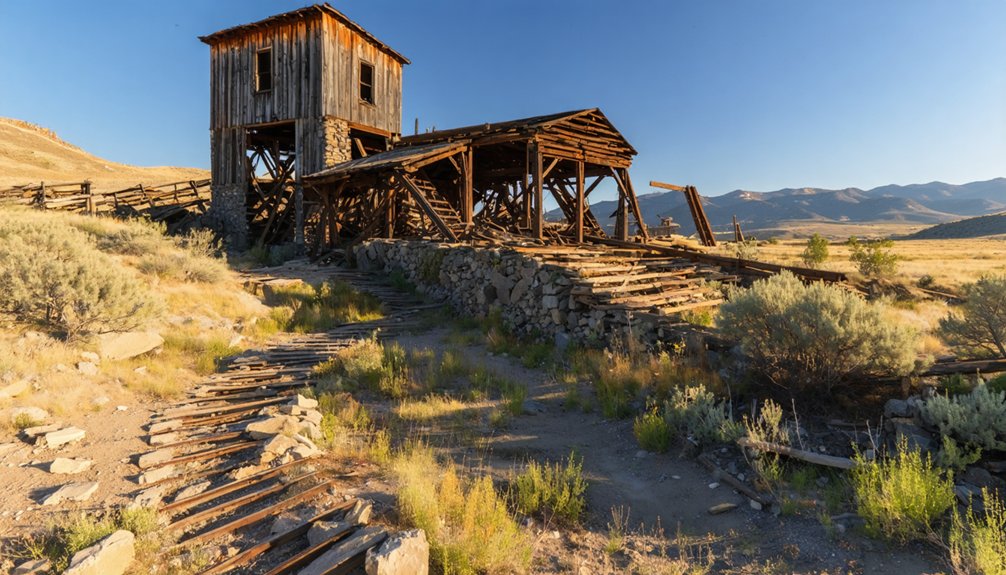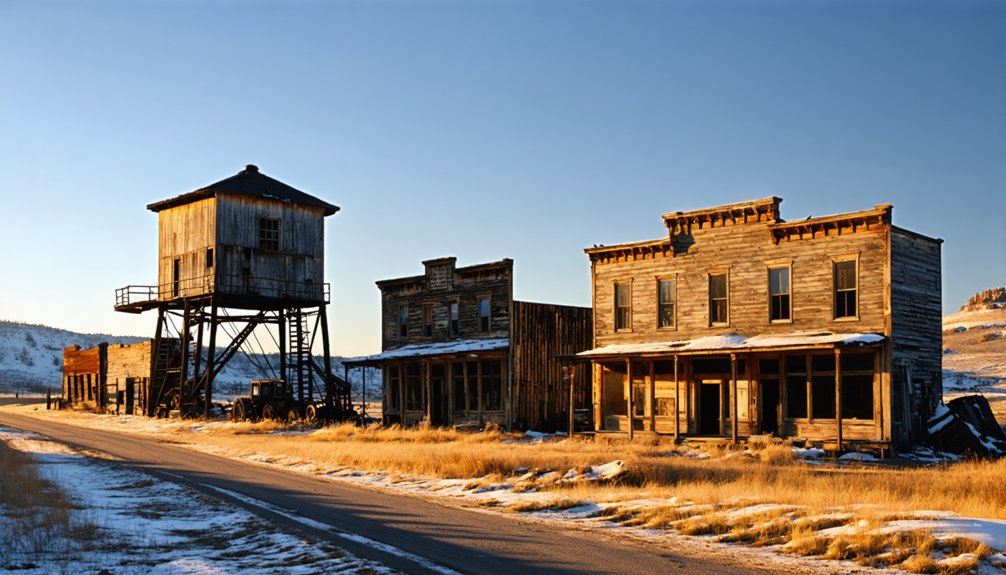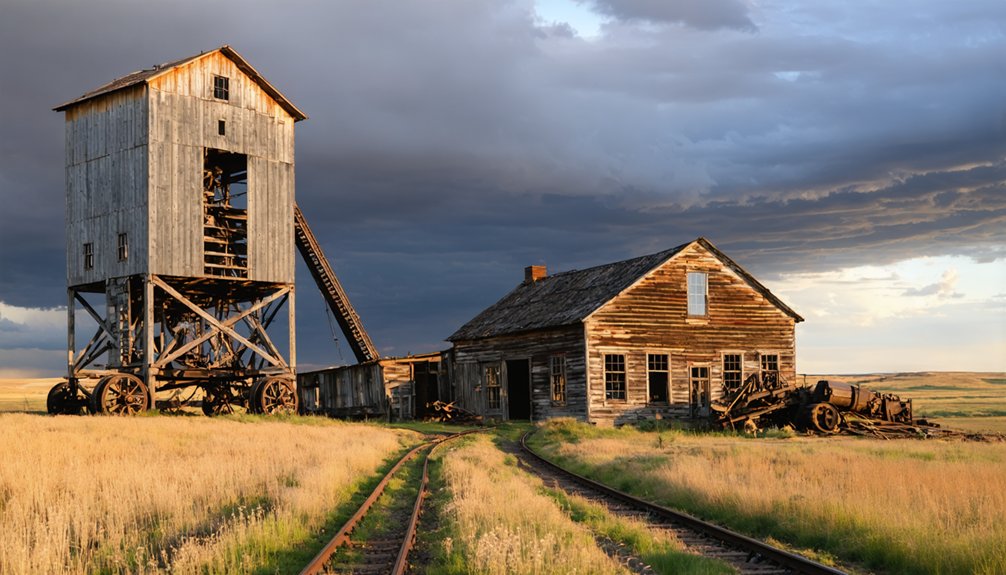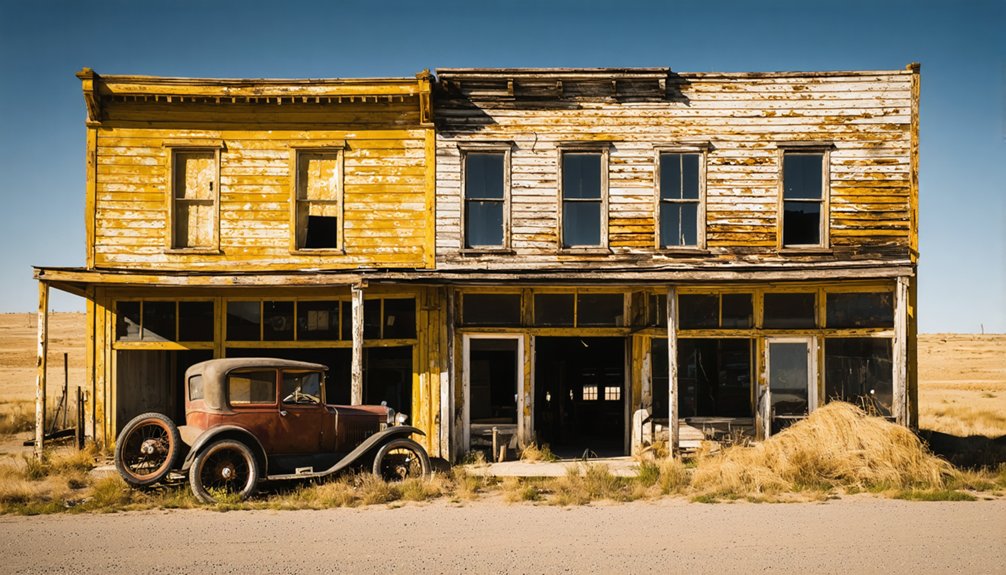You’ll find Golden Summit’s remnants in South Dakota’s Black Hills, where it emerged as a gold mining boomtown in 1874. The settlement flourished with stamp mills, shaft houses, and ore processing facilities that supported dangerous underground mining operations. While the town declined after World War I, you can still explore its weathered foundations and mining structures. The site’s crumbling architecture and mining ruins reveal a complex story of prosperity, innovation, and eventual abandonment.
Key Takeaways
- Founded in 1874 after gold discovery in the Black Hills, Golden Summit developed into a bustling mining town supporting local operations.
- The town featured essential mining infrastructure including shaft houses, ore bins, and a five-stamp mill for processing gold.
- Daily life centered around grueling mining shifts, with workers enduring dangerous conditions and exposure to toxic chemicals.
- Golden Summit declined during World War I due to mining restrictions and complex extraction conditions, leading to abandonment.
- Remaining ruins include processing facilities, shaft houses, and mill structures that showcase the town’s mining heritage.
The Origins of Golden Summit
When gold was discovered in the Black Hills in 1874, it sparked a series of mining settlements that would eventually include Golden Summit, a hard rock mining town in Pennington County, South Dakota.
You’ll find its founding significance deeply rooted in the region’s mineral wealth, as the town emerged around the turn of the 20th century to support intensive mining operations. Like many other towns in the area, Golden Summit relied on the Concord stagecoaches for transportation of goods and people.
The community aspirations were high as Golden Summit quickly developed essential infrastructure, including shaft houses, ore bins, and processing facilities.
Like many Black Hills settlements, you’d have seen a town driven by the promise of prosperity, attracting miners and entrepreneurs who established businesses and built homes.
The population ebbed and flowed with mining yields, while the town’s destiny remained firmly tied to the success of its mineral extraction endeavors. Instead of finding gold, the settlers discovered deposits of silver and copper which became crucial to the town’s development.
Mining Operations and Economic Growth
As Golden Summit’s mining operations intensified in the early 1900s, you’d have witnessed a remarkable transformation of the local economy through innovative extraction techniques and processing methods.
Mining innovations, including mercury amalgamation and later cyanide processing, revolutionized the extraction of both free milling and refractory gold ores, driving economic sustainability throughout the region. The introduction of the chlorination and smelting process by 1890 marked a crucial advancement in processing complex ores. A five stamp mill established early in operations proved essential for crushing and processing gold-bearing ore.
- Infrastructure expanded rapidly with new railroads and timber operations supporting the mining industry
- Employment opportunities attracted skilled workers, growing the town’s population
- Local businesses flourished, creating a diverse economic ecosystem
- Technological advancements in ore processing increased mining efficiency
- The development of support industries strengthened the town’s economic foundation
These developments positioned Golden Summit as a significant contributor to South Dakota’s mining heritage, though like many mining towns, its prosperity would eventually face challenges from market forces and resource depletion.
Life in a Black Hills Mining Town
You’d find miners working grueling shifts in the dangerous underground tunnels, where teams extracted and processed ore using mercury amalgamation to recover small amounts of gold.
After their shifts, workers would head to the town’s saloons, gambling halls, and entertainment venues that served as social gathering spots for the mainly male workforce. The Homestake Mine became the region’s dominant gold producer for over a century.
Your life in Golden Summit would’ve included access to basic amenities like wooden housing, churches, and schools as the settlement evolved from a makeshift camp into a more structured community with established businesses and services. The discovery of gold at French Creek in 1874 had sparked the initial rush of prospectors to the area.
Daily Mining Routines
During the Black Hills mining era, miners adhered to a strict daily schedule that began well before their 7:00 a.m. shift.
You’d find yourself rising early to trek by foot or horseback to the work site, where mining schedules demanded unwavering discipline for 10-hour shifts of intense physical labor. After arriving, you’d retrieve your dry work clothes from the dedicated drying room. The use of toxic chemicals like mercury in nearby processing areas made protective clothing essential.
You’d descend into the mines via ladders called “manways,” avoiding the swaying buckets for safety.
Your work would involve rotating positions during double or triple jacking, switching every 15 minutes.
You’d swing heavy hammers at about 50 strikes per minute during single jacking operations.
In confined spaces, you’d use 4-pound hammers for overhead drilling.
You’d navigate varying conditions from warm, humid areas to cool, damp sections while dealing with seeping moisture and standing water.
Social Life After Work
While miners endured grueling days underground, their social lives thrived in the bustling atmosphere of Black Hills mining towns. You’d find yourself drawn to saloons and dance halls, where miner’s gatherings centered around poker games, storytelling, and heavy drinking. The Gem Variety Theater provided popular entertainment for the town’s residents.
For $1 a night, you could secure a cot in a crowded boardinghouse, where communal meals and informal social connections flourished.
Despite the primarily male population, leisure activities adapted to create a unique cultural atmosphere. You might catch entertainment at brothels in Deadwood’s “Bad Lands” or join public celebrations at miner’s halls. The town of Deadwood grew rapidly to accommodate 7,000 residents by 1876, leading to a diverse and lively social scene.
The railroad’s presence guaranteed a steady flow of visitors and supplies, while stage stations offered additional places to socialize.
Though lawlessness mixed with camaraderie, these social spaces provided essential relief from the demanding mining life.
The Rise and Fall of Golden Summit
As miners discovered placer gold in the Black Hills region during the 1874 gold rush, Golden Summit emerged as a promising mining settlement that would experience both remarkable success and eventual decline.
The mining heritage of Golden Summit reflects the broader gold rush narratives of the Black Hills, where initial surface yields brought prospectors $8,000 in early profits.
- High-grade ore veins and proximity to successful mining districts like Deadwood attracted significant investment
- Miners employed trenching and cross-cutting techniques to follow narrow, valuable veins
- Mercury amalgamation and gravity methods helped process the ore effectively
- Custom mills in the region supported the processing of Golden Summit’s extracted minerals
World War I restrictions and increasingly complex mining conditions ultimately led to the town’s decline.
Architectural Remnants and Mining Infrastructure

As you explore Golden Summit’s remains, you’ll find timber-framed shaft houses and partially intact mill structures that showcase the site’s industrial mining heritage.
The foundations of heavy processing equipment, including stamp mills and ore crushers, reveal the scale of mineral extraction operations that once dominated this landscape.
Ruins of ore processing facilities, complete with remnants of sluice boxes and settling ponds, demonstrate the complex methods used to separate precious metals from raw ore during the mine’s productive years.
Shaft Houses and Mills
The architectural remnants of Golden Summit’s shaft houses and mills showcase both historical mining practices and modern infrastructure developments.
There appears to be an error in addressing Golden Summit as a South Dakota location, as historical records indicate it’s actually in Alaska.
When examining mining infrastructure in South Dakota’s Black Hills region, you’ll find different examples like the Gold Mountain Mine with its distinctive mill frame.
- Traditional shaft house construction utilized local wood and stone materials
- Historic mills required extensive restoration due to environmental damage
- Modern mining facilities incorporate advanced safety protocols
- Shaft houses must maintain structural integrity through regular maintenance
- Tourism opportunities allow you to explore preserved mining structures while learning about historical extraction methods
For authentic South Dakota mining heritage, you’ll want to visit preserved sites within the Black Hills National Forest, where rustic architectural designs reflect the practical needs of early mining operations.
Mining Equipment Foundations
While exploring Golden Summit’s mining foundations, you’ll discover an intricate network of timber framing, concrete bases, and metal anchor points that once supported massive extraction equipment.
The timber foundations extend nearly a mile underground, showcasing the innovative engineering solutions miners developed to support heavy machinery and stabilize rock walls.
You can trace the mine’s operational history through concrete stability features, including remnant processing plant foundations and tailings containment structures.
Steel framework anchors reveal where hoisting towers and conveyor systems once stood. These foundations weren’t just functional – they’re now archaeological treasures that map out Golden Summit’s industrial footprint.
At tunnel entrances, you’ll find evidence of rock bolt systems and timber cribbing that prevented portal collapse, essential features that kept the mine operational.
Processing Facility Ruins
Massive concrete foundations and corroded metal frames dominate Golden Summit’s processing facility ruins, offering a glimpse into the site’s industrial past.
You’ll find evidence of historic processing techniques throughout the complex, from remnants of cyanide leaching tanks to deteriorated flotation cells. The environmental impact of these operations is still visible in the tailings ponds and waste containment areas.
- Concrete mounting pads reveal the locations of heavy crushers and grinders
- Rail tracks and conveyor systems show material flow pathways through the facility
- Connection tunnels link processing buildings to underground mining shafts
- Ventilation infrastructure and hoist rooms display engineering complexity
- Electrical substation foundations indicate the scale of power requirements
You can trace the complete ore processing journey from the visible infrastructure, from initial crushing to final extraction.
Historical Significance in South Dakota

Mining operations in Golden Summit, South Dakota played an essential role in shaping Pennington County’s early 20th-century development. As one of over 400 ghost towns in the Black Hills region, Golden Summit’s economic impacts extended beyond mineral extraction, influencing settlement patterns and regional industrialization from 1900 to 1920.
You’ll find Golden Summit’s cultural heritage preserved in its remaining foundations and mining structures, which offer valuable insights into frontier life and early industrial technologies.
The town’s story mirrors the broader narrative of the American West, where communities rose and fell with the rhythm of mineral discovery and depletion. The site’s ruins serve as a testament to South Dakota’s mining legacy, educating visitors about the boom-bust cycles that characterized the state’s economic development during this transformative period.
Ghost Town Tourism and Exploration
When you explore Golden Summit Ghost Town, you’ll need to follow essential safety protocols, including wearing sturdy boots and avoiding unstable structures.
The best time to visit is during the summer months between June and August when the weather is mild and the terrain is most accessible.
You can enhance your experience by booking one of the local certified guides who offer extensive tours of the site and share detailed historical knowledge.
Safety First When Exploring
Safety considerations must take precedence before beginning any ghost town exploration, as these historic sites often harbor numerous hazards that can pose serious risks to unprepared visitors.
Your risk assessment should include checking structural integrity and weather conditions before entering any buildings at Golden Summit.
- Always wear proper safety gear: sturdy boots, long pants, long sleeves, and protective gloves with rubberized grips
- Bring multiple light sources and extra batteries – you’ll need reliable illumination to navigate dark interiors safely
- Never explore alone – maintain a group of at least three people and inform someone of your plans
- Carry a first aid kit and fully charged cell phone for emergency situations
- Watch for hazards like exposed wiring, unstable floors, and harmful substances such as asbestos or mold spores
Best Times To Visit
Planning your visit to Golden Summit requires careful consideration of seasonal conditions and local events.
Spring and summer months offer the most favorable conditions, with mild weather providing ideal access to remote areas and enhanced visitor experiences. You’ll find the trails more navigable and the photography opportunities more abundant during these peak seasons.
To maximize your exploration, align your visit with local festivals and events that celebrate the Black Hills’ rich mining heritage.
These gatherings not only enrich your understanding of the area’s history but also provide unique opportunities to connect with the local community.
Consider that seasonal trends show increased tourist activity during these warmer months, so you’ll want to plan accommodations accordingly, especially if you’re planning to explore multiple ghost towns in the region.
Local Guide Services Available
To enhance your exploration of Golden Summit, several local guide services offer extensive tours that combine historical expertise with safety-minded leadership.
These professional guides help you navigate the challenging terrain while sharing authentic stories of the town’s mining heritage.
- Local guides provide detailed maps and historical documentation to enhance your understanding of key structures.
- Tour services include specialized photography sessions at prime viewpoints during ideal lighting conditions.
- You’ll gain access to normally restricted areas with proper safety equipment and supervision.
- Guides coordinate with local information centers to offer the most up-to-date trail conditions and site accessibility.
- Each tour service contributes to preservation efforts through a portion of their fees, helping maintain the site’s historical integrity.
You’ll find these guide services essential for maximizing both safety and educational value during your ghost town exploration.
Preservation Challenges and Efforts
While Golden Summit holds significant historical value, the ghost town faces numerous preservation challenges that threaten its remaining structures and artifacts.
You’ll find the town’s buildings rapidly deteriorating due to harsh Black Hills weather and decades of neglect, while mining waste and unstable ground conditions complicate preservation techniques. The site’s remote location makes maintenance difficult, and environmental remediation is essential to address toxic residues from ore processing.
Limited funding presents another major obstacle, as government resources typically flow to more prominent sites like Deadwood. Legal disputes over land ownership and active mining operations further restrict preservation efforts.
What preservation work does occur focuses mainly on stabilizing existing structures rather than full restoration, relying heavily on volunteer efforts despite seasonal accessibility challenges.
Mining Technology and Methods

Mining operations at Golden Summit evolved dramatically from basic placer techniques to sophisticated extraction methods over the town’s history.
You’ll find that gold extraction progressed from simple panning to complex mechanized systems, reflecting the mining innovations that transformed the industry.
- Early miners relied on basic tools like pans and sluice boxes to separate gold from stream sediments.
- Underground mining emerged as prospectors followed gold-bearing veins deep into the earth.
- Stamp mills revolutionized ore processing, crushing rock to release precious metals.
- Chemical extraction methods, particularly cyanide leaching, maximized recovery rates.
- Modern exploration used diamond drilling and geochemical analysis to precisely locate deposits.
The transformation from manual labor to mechanized operations brought efficiency but also changed the character of mining communities like Golden Summit forever.
Legacy of the Black Hills Gold Rush
As the Black Hills Gold Rush transformed the Dakota Territory in 1874, its complex legacy reshaped the American West through profound economic, social, and cultural changes.
You’ll find this legacy etched deeply in the region’s cultural significance, from the bitter memory of broken treaties with the Lakota Sioux to the establishment of enduring settlements like Deadwood and Lead.
While the Homestake Mine’s 40 million ounces of gold created immense wealth, the environmental impact scarred the landscape through extensive excavation and contamination.
The rush’s aftermath left abandoned mines and ghost towns as silent witnesses to this turbulent era.
Today, you’ll recognize the ongoing tension between economic development and Indigenous rights, as the Sioux’s refusal of financial compensation in favor of land restoration highlights their unwavering connection to these sacred hills.
Frequently Asked Questions
Are There Any Reported Ghost Sightings or Paranormal Activity in Golden Summit?
You won’t find documented ghostly encounters or spectral sightings specific to this location, though nearby mining ghost towns report paranormal activity. Regional patterns suggest potential hauntings, but there’s no concrete evidence.
What Happened to the Residents’ Personal Belongings After They Abandoned Golden Summit?
Over 90% of residents’ belongings were left behind, as you’d expect. Abandoned artifacts tell resident stories of hasty departures – they couldn’t transport everything when mining fortunes collapsed.
Did Any Famous Outlaws or Historical Figures Visit Golden Summit?
While outlaw legends abound in the Black Hills region, you won’t find documented historical visits of famous figures to Golden Summit specifically – nearby towns like Deadwood attracted the era’s notable characters instead.
Were There Any Major Accidents or Disasters During Golden Summit’s Mining Operations?
Like scrolling through a dead iPhone’s history, you won’t find any confirmed mining accidents or disaster reports from Golden Summit’s operations. Historical records don’t document major catastrophes during its active years.
What Was the Peak Population of Golden Summit During Its Most Prosperous Period?
You won’t find exact population records for peak numbers during the mining boom, though population trends suggest a small, fluctuating community typical of Black Hills mining settlements.
References
- https://www.sdpb.org/rural-life-and-history/2023-08-21/some-black-hills-ghost-towns-and-their-origins
- https://news.icpc.global/2017/04/22/gold-dreams-became-a-ghost-town-in-south-dakota/
- https://www.youtube.com/watch?v=Glucs_Rq8Xs
- https://www.blackhillsbadlands.com/blog/post/old-west-legends-mines-ghost-towns-route-reimagined/
- https://www.powderhouselodge.com/black-hills-attractions/fun-attractions/ghost-towns-of-western-south-dakota/
- https://www.sdhspress.com/journal/south-dakota-history-2-2/some-black-hills-ghost-towns-and-their-origins/vol-02-no-2-some-black-hills-ghost-towns-and-their-origins.pdf
- https://en.wikipedia.org/wiki/List_of_ghost_towns_in_South_Dakota
- https://www.youtube.com/watch?v=De3wGn9KDkg
- https://freepages.history.rootsweb.com/~gtusa/usa/sd.htm
- https://history.sd.gov/museum/docs/Mining.pdf



